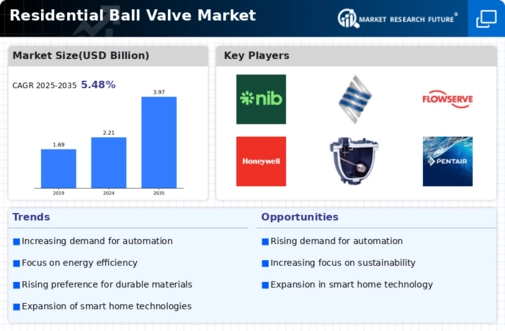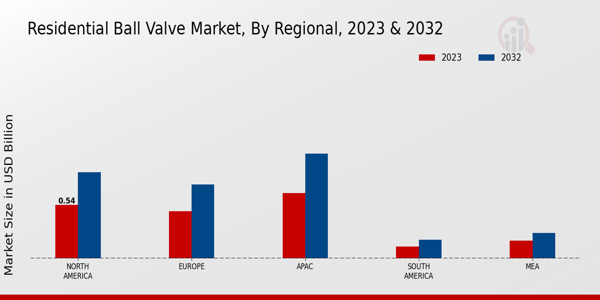Market Growth Projections
The Global Residential Ball Valve Market Industry is poised for substantial growth, with projections indicating a market value of 2.21 USD Billion in 2024 and an expected increase to 3.97 USD Billion by 2035. This growth trajectory reflects a compound annual growth rate of 5.46% from 2025 to 2035. Factors contributing to this growth include technological advancements, regulatory support for water conservation, and rising consumer awareness of sustainable practices. As the market evolves, it is likely to witness innovations that enhance the efficiency and reliability of ball valves, further solidifying their position in residential plumbing applications.
Expansion of the Construction Sector
The expansion of the construction sector globally is a significant driver for the Global Residential Ball Valve Market Industry. As new residential projects emerge, the demand for high-quality plumbing solutions, including ball valves, is expected to rise. This growth is fueled by urbanization and population growth, leading to increased housing needs. The market is projected to grow from 2.21 USD Billion in 2024 to 3.97 USD Billion by 2035, reflecting the construction industry's robust performance. The anticipated CAGR of 5.46% from 2025 to 2035 indicates that as construction activities ramp up, the demand for reliable plumbing components will follow suit.
Regulatory Support for Water Conservation
Regulatory frameworks promoting water conservation play a crucial role in shaping the Global Residential Ball Valve Market Industry. Governments worldwide are implementing stringent regulations aimed at reducing water wastage, which directly impacts the demand for efficient plumbing solutions. Ball valves, with their ability to provide precise flow control, are increasingly being specified in residential construction projects. This regulatory push is expected to drive market growth, as homeowners and builders seek compliant solutions. The anticipated market growth from 2.21 USD Billion in 2024 to 3.97 USD Billion by 2035 underscores the importance of regulatory support in fostering sustainable plumbing practices.
Rising Awareness of Sustainable Practices
The rising awareness of sustainable practices among consumers significantly impacts the Global Residential Ball Valve Market Industry. Homeowners are becoming more conscious of their environmental footprint, leading to increased demand for products that promote water efficiency. Ball valves, known for their reliability and minimal leakage, are increasingly viewed as essential components in sustainable plumbing systems. This shift in consumer behavior is likely to drive market growth, with projections indicating an increase from 2.21 USD Billion in 2024 to 3.97 USD Billion by 2035. The anticipated CAGR of 5.46% from 2025 to 2035 suggests that sustainability will remain a key driver in the residential plumbing sector.
Growing Demand for Efficient Water Management
The Global Residential Ball Valve Market Industry experiences a surge in demand driven by the increasing need for efficient water management systems. As urbanization progresses, the necessity for reliable plumbing solutions becomes paramount. Ball valves, known for their durability and low-pressure drop, are increasingly favored in residential applications. This trend is reflected in the projected market value of 2.21 USD Billion in 2024, with expectations to reach 3.97 USD Billion by 2035. The compound annual growth rate of 5.46% from 2025 to 2035 indicates a robust market trajectory, suggesting that homeowners are prioritizing water conservation and efficient plumbing solutions.
Technological Advancements in Valve Manufacturing
Technological advancements in the manufacturing processes of ball valves significantly influence the Global Residential Ball Valve Market Industry. Innovations such as automated production lines and the use of advanced materials enhance the performance and longevity of these valves. Manufacturers are increasingly adopting smart technologies, enabling remote monitoring and control of residential plumbing systems. This shift not only improves efficiency but also aligns with the growing trend towards smart homes. As a result, the market is expected to see a steady increase in demand, contributing to the projected growth from 2.21 USD Billion in 2024 to 3.97 USD Billion by 2035.













